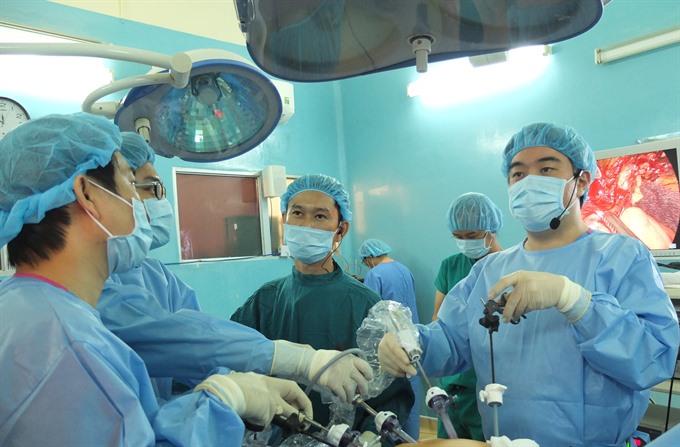 Society
Society

Doctors at Bình Dân Hospital in HCM City has performed surgery for the first time using indocyanine fluorescence imaging to treat gastric cancer.
 |
| Doctors at Bình Dân Hospital in HCM City perform surgery on a patient with gastric cancer. — Photo courtesy of Bình Dân Hospital |
HCM CITY — Doctors at Bình Dân Hospital in HCM City has performed surgery for the first time using indocyanine fluorescence imaging to treat gastric cancer.
The imaging, which helped localise the boundary between a cancerous tumour and healthy tissues, identified sentinel nodes that were removed along with a 15 mm-cancerous tumour.
Several months ago, the patient began having symptoms such as flatulence and abdominal pain, and later bought medicine. But his condition worsened.
At Bình Dân Hospital, the man was diagnosed with gastric cancer at an early stage. The cancerous tumour was small and had not spread to the deeper layers of the stomach wall.
Despite the early stage of the disease, gastric tumours can spread to other organs, mostly the liver, lungs and peritoneum, according to doctors.
Both cancerous tumours and suspected nodes should be removed to ensure effectiveness in treatment, they said.
The patient has recovered well after a surgery on March 30 and is receiving chemotherapy to kill the remaining cancerous tumours.
Dr Trần Vĩnh Hưng, director of Bình Dân Hospital, said that gastric cancer surgery using indocyanine fluorescence imaging requires surgeons with experience and training in knowing how to precisely inject the substance into the stomach.
This kind of imaging is being used to diagnose and assist surgeries to treat breast cancer and respiratory, cardiovascular and urologic diseases.
According to figures released at a conference last year, Việt Nam has more than 15,000 annual new incidences of gastric cancer, including more than 11,000 fatalities a year.
Gastric cancer is the second most common cancer among men and fifth most common among women in Việt Nam. — VNS




